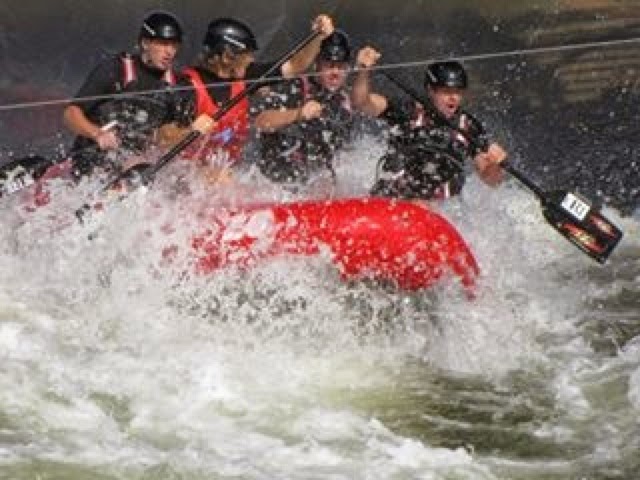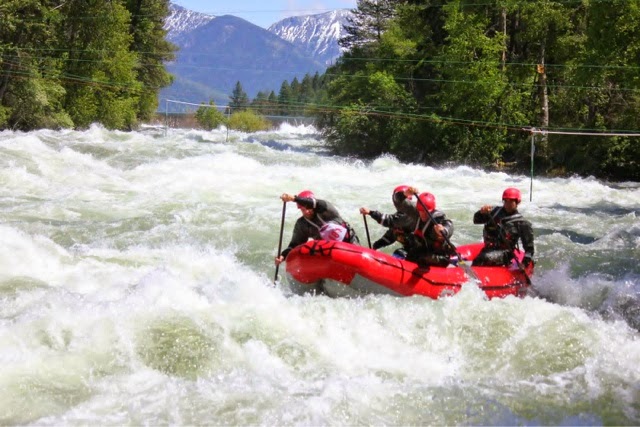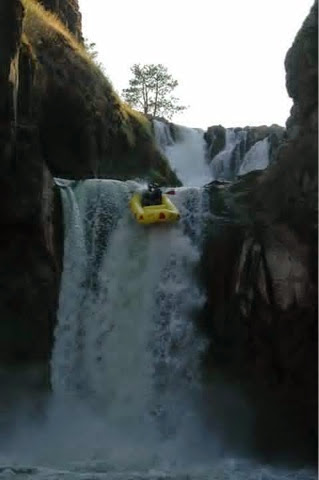The Oregon Rafting Team (ORT) of the USA is a unique team and they are much more than just a competitive team. They also engage in volunteer work which includes river cleanups, search and rescue missions, as well as coordinating events. Their trademark has become shooting waterfalls and their adventures take our breath away. Many admire them and imagine that one day they too will do something like that. They are a diverse group of athletes. You can find a former Olympic medalist, college football linebacker, endurance runners, climbers, skiers, snowboarders, mixed martial artists, kayakers, rugby players, wrestlers, swimmers, kick-boxers, and of course a few dirtbag river guides.
Joker, Professor, Pork Chop, The Maverick, Grizz, The Law, Saggy, Ox, Dirty, and Certified and Timber make the basic crew of the Oregon Rafting Team. Since 2002, this team has built up it’s position in the rafting world. ORT has placed in the top five nationally for the past 7 years and has won 46 of the 51 events entered at their regional level during that same period. If you are a member of the team it does not mean you are guaranteed a place in the raft. ORT athletes have to compete with each other to earn a spot on the “Red Team”.
Watching their actions, many of us can not connect them to the competition scene, but they see it differently. “Downriver races with head to head starts are our favorite types of races,” says the man who started ORT, Tim Brink. “Racers should have the opportunity to match up head to head while eliminating the variable of timers.”
With competitions in Europe opening this year with up to 70 teams at the European Championships, “we have thought about coming to Europe yet our schedule is currently year round and we do many different types of boating in addition to racing. Time and money is not as abundant as we would like. Nobody in the world does ALL the things we do. It’s wonderful to see how dedication and the love of rafting can build a team that pushes the boundaries of the sport. Tim was interviewed by myself for an article for the International Rafting Federation earlier this year.
Nada: Since we mostly see the team made up of male competitors, we wanted to know whether we can hope for a women’s ORT?
Tim: “We have recently been assisting yet another group of ladies (which includes my wife Caitlin) to begin a racing team called Stout Creek Women’s Rafting Team. Historically, we have assisted many women’s teams in some form.
Nada: Rafters admire you because you are pushing the boundaries of rafting to the edge and usually the edge of the waterfall. How did you start with this?
Tim: After years of contemplation I began running waterfalls starting with Big Brother on the White Salmon. Historically, rafters (and most boaters really) were groomed to think waterfalls were of a Class VI rating and unnavigable. In the past several years this has obviously changed.”
Nada: It sure has, and you have had a major role in that.
Tim: The key is how will one stay in the boat without injury? Our techniques include keeping the nose light by removing the rear thwart and laying in the stern of the boat, having something to hold on to near the floor that would not move after violent impacts, and using only 2 paddlers to diminish the chance of striking another occupant on impact.
Over time these techniques have been modified, yet for the largest drops, say 30 feet or more the aforementioned strategies are still best practice. Setting a precedent of this nature takes a significant leap of faith thus our mindset had a great deal of finality.
Nada: For all the things that you do you should be well trained in all aspects of the potential situation – so those who watch your videos need to know that everything you are doing is the result of good training and preparation as well as technique and big experience. What is your advice to those who want to try what you did?
Tim: One can get away with trying big drops many times without consequence but to do so for several years without critical injury the following premises should strictly be adhered to:
A high standard of physical fitness.
Profound knowledge of the limits of your equipment.
Profound knowledge of hydrology.
Engage in attempts only with people you trust.
Mentally rehearse 3 or more contingency plans both with the running of the drop and if something goes wrong.
Nada: Tim, what happens when one of you gets hurt when paddling?What are the difficulties in pulling someone out of the river which are, in most cases, in a canyon and far away from infrastructure (roads, hospitals..)? What is the most critical situation in which you have found yourself so far?
Tim: Joker missed his grab when dropping a local waterfall this weekend and now needs screws in his collar bone. Dislocating my hip after dropping over the 45 foot Celestial Falls was my worst experience. At least there were roads near by, and 4 other paddlers to assist with extracting me up a steep trail to the ambulance. The hospital was about one painful hour away. Doing something of this magnitude without communication or road access is highly problematic. However, the human body can endure a significant amounts of trauma and abuse. If this is your mind set, then also ensure your team mates are up to the task of rescuing you or worse such as dealing with a very bad memory for the rest of their life. “
Nada: You have paddled many rivers, which would you recommend to us?
Tim: I need to get overseas so my list is somewhat limited. I have always had a full time job and/or been in school so my life has had a more chosen structure in comparison to many river runners. The Upper Upper Cispus in Washington is a Class V favorite.
The Little White Salmon also in Washington is one in which I need to learn the lines better and get on more often. The Upper Wind in Washington is a nearby challenging Class IV+ run that is entertaining.
Canyon Creek Washington is another nearby IV+ run with straight forward gorgeous big drops.
The Cal Salmon in California is great for the entire experience of being on and around a river.”
I
Nada: Everything ORT do is a result of love for the sport, dedication, perseverance… and the help of sponsors. You have a lot of sponsors, who are they and whether it was difficult to find them?
Tim: Our sponsors: AIRE, sweet protection, KEEN, Next Adventure, Sawyer, TEAM QUEST, Whitewater Designs, NINKASI, kershaw, and O-S-Systems, 7 of which are from Oregon while the other 3 have solid roots and representation in our region. We work hard to ensure that our sponsors feel a part of what we are doing and are always getting what they need from us, a win-win. We maintain this positive energy through good communication, professional presentation, blogs, pictures, videos, and working with sponsors that have great products we believe in.”
We’ve done the brief introduction – now you can find out more at their great, regularly updated website or follow them on Facebook. In any case, think twice before you do something like they are doing, or simply enjoy their adventures from afar. We will certainly continue to follow and admire their actions. Thank you Tim for your help and all the best to “ORT” from IRF.








